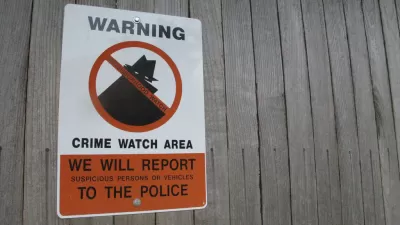Homicides are decreasing nationwide, but a federal study reveals that the rate has decreased about 17% in cities and increased by the same rate in suburbs. Two WSJ reporters look behind the numbers for the causes with a focus on Atlanta's suburbs.

Cameron Mcwhirter and Gary Fields report on the murder of an African immigrant who opened a store in a "violent area" in southwest Atlanta but was shot outside his "modest home on a quiet street" in the unincorportated are of Riverdale in Clayton County. They refer to a recent study of the federal Bureau of Justice Statistics and a May 2011 study by the Brookings Institution.
"Today, suburban murders, from domestic violence to robberies gone bad to massacres like the Newtown, Conn., school shootings, make up about a quarter of all homicides in the U.S., up from 20.7% in 2001, according to the BJS. The sharpest increases in violent crime appear to be in suburbs of cities, including those of Houston, Pittsburgh, and Atlanta. The violent-crime rate in Atlanta's suburbs rose 23% between 2000 and 2008, while the city of Atlanta's violent-crime rate dropped 49% (according to Brookings)."
Mcwhirter and Fields suggest that the increase in suburban crime are related to the demographic movement in and out of central cities.
"New suburban residents include people who moved from tough urban neighborhoods, lured in part by cheaper rents in some suburbs like Clayton County. Some were pushed out of cities like Atlanta by urban gentrification and public-housing demolition. Many hoped for less crime, but some who came were criminals."
While the media has been captivated by the increase in crime in Chicago, they have spent less time on the plummeting homicide rate in the nation's largest city.
Wendy Ruderman of the New York Times writes on Dec. 28 that "(m)urders in New York have dropped to their lowest level in over 40 years, city officials announced on Friday, even as overall crimes increased slightly because of a rise in thefts — a phenomenon based solely on robberies of iPhones and other Apple devices."
The prevalence of crime in fact may be among the most important aspects of urbanity, if not civilization.
“The essence of civilization is that you can walk down the street without having to look over your shoulder,” Mayor Michael R. Bloomberg said.
Contributor's Note: Access to article may be time-limited without subscription.
FULL STORY: Crime Migrates to Suburbs

Alabama: Trump Terminates Settlements for Black Communities Harmed By Raw Sewage
Trump deemed the landmark civil rights agreement “illegal DEI and environmental justice policy.”

Planetizen Federal Action Tracker
A weekly monitor of how Trump’s orders and actions are impacting planners and planning in America.

The 120 Year Old Tiny Home Villages That Sheltered San Francisco’s Earthquake Refugees
More than a century ago, San Francisco mobilized to house thousands of residents displaced by the 1906 earthquake. Could their strategy offer a model for the present?

Ken Jennings Launches Transit Web Series
The Jeopardy champ wants you to ride public transit.

BLM To Rescind Public Lands Rule
The change will downgrade conservation, once again putting federal land at risk for mining and other extractive uses.

Indy Neighborhood Group Builds Temporary Multi-Use Path
Community members, aided in part by funding from the city, repurposed a vehicle lane to create a protected bike and pedestrian path for the summer season.
Urban Design for Planners 1: Software Tools
This six-course series explores essential urban design concepts using open source software and equips planners with the tools they need to participate fully in the urban design process.
Planning for Universal Design
Learn the tools for implementing Universal Design in planning regulations.
Clanton & Associates, Inc.
Jessamine County Fiscal Court
Institute for Housing and Urban Development Studies (IHS)
City of Grandview
Harvard GSD Executive Education
Toledo-Lucas County Plan Commissions
Salt Lake City
NYU Wagner Graduate School of Public Service




























